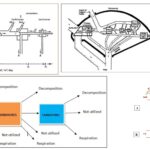Explain the dominance and overdominance hypotheses of heterosis giving their muin features, objections and answers to the objections. Which of the above two hypotheses is more widely accepted and why ?
Botany 40 Views 1 Answers
Sourav PanLv 9September 13, 2024
Explain the dominance and overdominance hypotheses of heterosis giving their muin features, objections and answers to the objections. Which of the above two hypotheses is more widely accepted and why ?
Please login to save the post
Please login to submit an answer.
Sourav PanLv 9May 15, 2025
Dominance and Overdominance Hypotheses of Heterosis
1. Dominance Hypothesis
Main Features:
- Basic Idea: The dominance hypothesis posits that heterosis results from the masking of deleterious recessive alleles by dominant alleles in the hybrid. Essentially, the hybrid benefits from the dominance of beneficial traits and the suppression of harmful traits present in the homozygous parent lines.
- Mechanism: In this hypothesis, heterozygotes benefit from having one or more dominant alleles that mask the effects of recessive alleles which might be deleterious. This leads to improved performance in hybrid offspring compared to homozygous parent lines.
Objections:
- Incomplete Explanation: The dominance hypothesis does not account for the fact that heterosis can be observed in traits not related to simple dominance-recessive interactions.
- Limited Cases: It does not explain heterosis in cases where hybrids do not exhibit straightforward dominance relationships.
Answers to Objections:
- Complex Traits: Advances in genetics have shown that while simple dominance may play a role, other genetic mechanisms such as epistasis and gene interactions also contribute to heterosis.
- Broader Application: Evidence has demonstrated that while dominance may explain some instances of heterosis, the hypothesis is part of a broader set of mechanisms that contribute to hybrid vigor.
2. Overdominance Hypothesis
Main Features:
- Basic Idea: The overdominance hypothesis suggests that heterosis results from the hybrid having an advantage due to the interaction between two different alleles at a single locus. This interaction creates a phenotype that is superior to both homozygous parent lines.
- Mechanism: According to this hypothesis, the hybrid exhibits superior traits because the heterozygote has a more optimal expression of the gene product than either of the homozygotes. This optimal expression can lead to enhanced growth, yield, or other beneficial traits.
Objections:
- Limited Evidence: There are limited cases where overdominance has been conclusively demonstrated, and it is often challenging to separate it from other phenomena such as epistasis.
- Complex Interactions: The overdominance hypothesis may oversimplify the complex interactions that can occur between different genes and alleles.
Answers to Objections:
- Empirical Evidence: Studies in specific cases, such as maize and human sickle cell anemia, have provided evidence supporting overdominance. Advances in molecular genetics continue to uncover more examples.
- Genetic Complexity: Modern genetic research recognizes that overdominance is one of several mechanisms contributing to heterosis, and it works in conjunction with other factors such as epistasis and linkage.
Acceptance of the Hypotheses
More Widely Accepted Hypothesis:
- Dominance Hypothesis: The dominance hypothesis is generally more widely accepted, primarily because it can explain a broader range of heterotic effects observed in many crop species and animals. Its simplicity and applicability to a variety of traits make it a practical framework for understanding hybrid vigor.
Reasons for Greater Acceptance:
- Practical Evidence: Dominance effects are easily observable in many breeding programs and can be practically applied to improve traits in crops and livestock.
- Broad Applicability: The dominance hypothesis provides a framework that aligns well with observed phenomena in a wide range of species, including those where detailed genetic mechanisms are not fully understood.
- Integration with Other Mechanisms: While dominance alone may not explain all cases of heterosis, it is often integrated with other mechanisms, such as epistasis and overdominance, to provide a comprehensive understanding of hybrid vigor.
0
0 likes
- Share on Facebook
- Share on Twitter
- Share on LinkedIn
0 found this helpful out of 0 votes
Helpful: 0%
Helpful: 0%
Was this page helpful?




